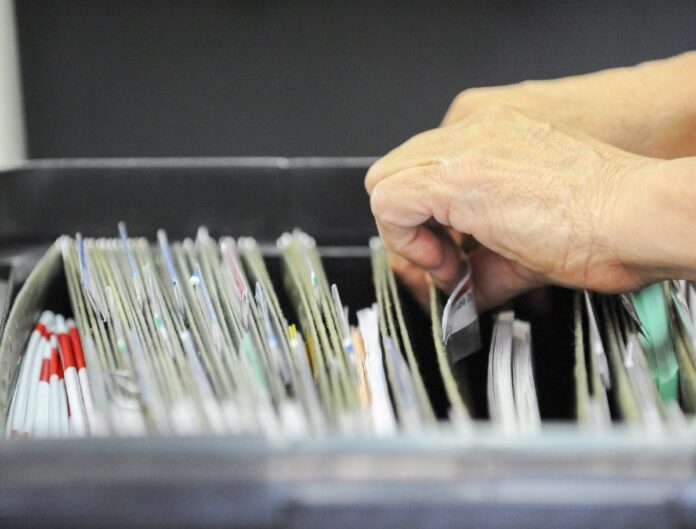HARLINGEN — Voting a straight-party ticket in Texas has ended.
Whether that’s good or bad pretty much depends on where one stands politically.
In 2016, straight-ticket voting was the choice of about 64 percent of voters in the largest 10 Texas counties. But Republicans claimed the straight-ticket vote was leading people to ignore down-ballot items like propositions, where vote totals were often 15 to 20 percent less than those received by individual candidates at the top of the ballot.
Here in Cameron County last week, there were 30,044 straight-ticket Democratic voters, 16,212 straight-ticket Republicans and 699 straight-ticket Libertarians. A total of 79,125 Cameron Count adults cast ballots, meaning 59 percent of voters opted for a straight-ticket ballot.
“I like straight-party voting because I think it gives the voters a chance, those who have strong party preferences, to move through the ballot quickly,” said Remi Garza, Cameron County elections administrator. “The quicker a voter is able to complete marking his ballot and cast it, it gives us the opportunity to put another person to vote in the booth.”
‘La palanca’
Straight-ticket voting is well known to Hispanic voters as “la palanca,” or “the lever,” a reference to old-style mechanical voting machines which Cameron County phased out 25 to 30 years ago. To cast a party-line vote, a voter pulled a lever for a party’s slate of candidates.
Republican county judge candidate Carlos Cascos is not going to lament the passing of straight-ticket voting.
He doesn’t blame it for his loss to incumbent County Judge Eddie Trevino Jr. by around 15,000 votes, but he feels it was definitely a factor in Texas elections and it favored Democrats.
He said in retrospect it would have been better for Republicans to have ended straight-ticket voting as an option for this election cycle, instead of waiting until 2020.
“I don’t know if it would have been the determining factor in my race, but I think it played a major, major role in the outcome of many elections, including mine,” Cascos said. “Who knows what would have happened? My deal is, yes, I think the straight-ticket had a lot to do with it.
“But you know what? You’ve got to play cards with the cards you’re dealt,” he added. “Those were the rules that were in place at the time of this election. You’ve got to live by them, lose by them and win by them. Fortunately, it does go away in 2020 and I think that’s going to level the playing field in highly Democratic areas that relied on straight-ticket voting and Republican areas that relied on straight-ticket voting.”
Democrats must adapt
Amber Medina, the Cameron County Democratic Party chair, is less enthusiastic about the end of straight-ticket voting, saying it will require a different approach when it comes to motivating voters within her party.
“I think that it is a concern because we’re going to have to educate our voters to definitely vote in every race and we’re going to have to work more on messaging and getting them the information about the candidates and how much it matters to vote in all the races and not just go in and vote for one candidate and that’s it,” she said.
Despite losing what many see is an advantage for Democratic Party candidates, Medina said she was heartened by the county’s Democratic turnout in the 2018 election, driven primarily by a surge of support in the Valley for Democratic U.S. Rep. Beto O’Rourke in his quest to unseat Republican Sen. Ted Cruz.
Last week’s election saw a major increase in turnout over the last off-year election, in 2014, in Cameron County. Voter turnout this year was 38 percent, compared to less than 22 percent in 2014. The statewide voter turnout this year was 53 percent.
Of those county voters, 63 percent went for O’Rourke and 37 percent for Cruz.
“Definitely a lot of it has to be attributed to the candidates,” she said. “They ran a very strategic, grassroots campaign and (O’Rourke) touched a lot of people and people really came out for him.
“I think there was that plus a lot of targeted efforts,” she added. “We’re also seeing the Trump effect. People came out to vote for Democrats because of what they’re seeing on the national level, the aftermath of 2016.”
Even more early voting?
Unofficially, of the 79,125 Cameron County voters who cast ballots, 54,687 of them opted to vote early, with just 24,285 casting ballots on Election Day.
Cameron County Elections Administrator Garza frets that, despite the increase in people participating in early voting, not having the option of a straight-ticket voting will slow things down next Election Day.
“I think what’s going to happen as a consequence of the removal of the straight-party ticket is that it’s going to take longer for all the voters to mark their ballots with their candidate choices,” Garza said.
“You’re going to either be focusing on local races, and so your state races might lose some votes that they normally would get when somebody marks that ballot, or they might just focus on the big-ticket races and some of the down-ballot positions will be overlooked because they really are only there to vote for a specific candidate or in a specific race,” he added.
2018 straight-ticket voting
Democrat — 30,044
Republican — 16,212
Libertarian — 699
Total votes cast — 79,125
Source: Unofficial Cameron County vote totals





